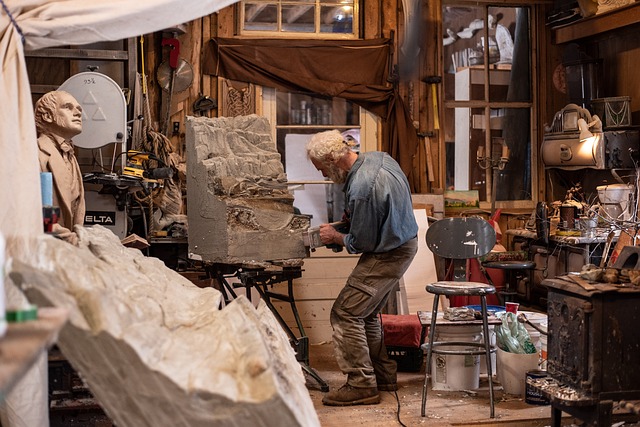Introduction
Setting up a successful craft business goes beyond creating beautiful products. A critical component of your business is your workspace, where you’ll spend countless hours working on your craft. An organized, efficient workspace can enhance your creativity, productivity, and overall well-being.
In this article, we’ll guide you through the process of setting up your workspace for your craft business, taking into account various factors, such as location, layout, equipment, and safety.
Importance of a well-organized workspace
A well-organized workspace is essential for running a successful craft business. It can boost productivity, reduce stress, and make your work more enjoyable. Additionally, an efficient workspace will help you maintain a professional image when meeting with clients or showcasing your work.
Factors to consider when setting up your workspace
When setting up your workspace, it’s essential to consider your craft’s specific needs, available space, budget, and personal preferences. By thoughtfully planning your workspace, you can create a functional, comfortable environment that supports your creative process.
Assessing Your Space Requirements
Before you begin setting up your workspace, it’s important to assess your space requirements. This includes determining the amount of space needed for your craft and considering any unique demands your craft may have.
Determine your workspace needs
Consider the size of your work surface, storage requirements, and any additional equipment you may need. Make a list of your must-haves and nice-to-haves, and prioritize them according to your budget and available space.
Consider your craft’s unique demands
Different crafts have unique demands. For example, a painter may require ample natural light, while a woodworker needs a well-ventilated space. Take the time to research your craft’s specific needs to ensure your workspace is tailored to support your work.
Choosing a Suitable Location
Once you have a clear understanding of your space requirements, it’s time to choose a suitable location for your workspace. This could be a dedicated room in your home, a rented commercial space, or a shared co-working space.
Home-based workspaces
Many craft business owners start by setting up their workspaces at home. This is a cost-effective option that allows for flexibility and convenience. To create a functional home workspace, designate a specific area or room for your craft, and ensure it’s free from distractions and household clutter.
Renting a commercial space
If your craft business has outgrown your home-based workspace or if you prefer to keep your work separate from your living space, renting a commercial space may be the right option for you. When searching for a suitable location, consider factors such as size, location, accessibility, and budget.
It is essential to prepare a rental resume to increase your chances of securing the desired commercial space. Your rental resume should include your name, contact information, and an objective statement outlining your goals when looking for a new rental.
Organizing Your Workspace
Once you have chosen a suitable location for your craft business, the next step is to organize your workspace. This includes planning the layout, investing in storage solutions, and considering ergonomic factors.
Workspace layout
An efficient workspace layout allows for easy movement and access to your tools and equipment. Make sure to allocate sufficient space for your work surface, storage, and any additional equipment you may need. When planning your layout, consider the workflow of your craft process and organize your workspace accordingly.
Storage solutions
Having an organized storage system is crucial to keeping your workspace clutter-free and efficient. Invest in storage solutions that cater to your specific needs, such as shelves, cabinets, and drawers. Consider using clear containers or labels to easily identify your supplies and materials.
Ergonomic considerations
A comfortable, ergonomic workspace can help prevent strain and injury while working on your craft. Ensure that your work surface, chair, and tools are at the correct height and position to promote proper posture and prevent discomfort.
Additionally, consider investing in ergonomic equipment, such as adjustable chairs and cushioned mats, to enhance your workspace’s comfort.
Essential Tools and Equipment
To set up a successful craft business, you’ll need to invest in essential tools and equipment. This includes both craft-specific tools and general equipment.
A. Craft-specific tools
Each craft requires unique tools to create beautiful, high-quality products. Research your craft’s specific tool requirements and invest in high-quality, durable tools that will last.
B. General equipment
Apart from craft-specific tools, there are some general pieces of equipment that are essential for most craft businesses. These may include a work table, chair, lighting, and basic office supplies. Consider investing in versatile, multi-purpose equipment to save space and money.
C. Technology
In today’s digital age, incorporating technology into your craft business can streamline your workflow and increase your efficiency. Consider investing in devices such as computers, tablets, and printers, as well as software for tasks like inventory management, invoicing, and marketing.
Lighting and Ventilation
Proper lighting and ventilation are essential for creating a comfortable and safe workspace. Good lighting can prevent eye strain and enhance the accuracy of your work, while adequate ventilation ensures a healthy work environment.
Natural light
Natural light is ideal for many crafts, as it provides even, accurate lighting that’s easy on the eyes. To maximize natural light in your workspace, choose a location with large windows or install skylights. Be sure to arrange your workspace so that it takes advantage of the available natural light.
Artificial lighting
In addition to natural light, artificial lighting is necessary to ensure that your workspace is well-lit throughout the day and during darker months. Invest in adjustable task lighting, such as desk lamps, floor lamps, or overhead lights, to illuminate your work area and prevent eye strain.
Ventilation
Proper ventilation is crucial for maintaining a healthy and safe workspace, particularly when working with materials that produce fumes or dust. Ensure your workspace has adequate ventilation by installing exhaust fans, air purifiers, or an HVAC system.
Safety Measures
Ensuring the safety of your workspace is of utmost importance. Implementing proper safety measures can prevent accidents and protect both you and your work.
Fire prevention
Keep your workspace safe from fire hazards by installing smoke detectors, fire extinguishers, and fire blankets. Regularly inspect and maintain electrical equipment, and avoid overloading power outlets.
Proper storage of hazardous materials
If your craft involves working with hazardous materials, such as chemicals or sharp tools, ensure they are stored securely and safely. Use proper containers and labels, and keep them out of reach of children or pets.
First aid kit
Accidents can happen in any workspace, so it’s essential to have a fully stocked first aid kit on hand. Regularly check and update your kit to ensure it contains all necessary items, such as bandages, antiseptic wipes, and pain relievers.
Customizing Your Workspace
Adding personal touches to your workspace can make it more enjoyable and inspiring. Customize your workspace to reflect your personality and preferences.
Personal touches
Incorporate personal items, such as family photos, artwork, or memorabilia, to make your workspace feel more inviting and comfortable.
Inspirational elements
Surround yourself with items that inspire your creativity, such as mood boards, inspiring quotes, or a vision board displaying your goals and aspirations.
Color schemes
Choose a color scheme for your workspace that reflects your personal style and promotes a positive, creative atmosphere. Different colors can evoke different emotions and energy levels, so consider how your chosen colors will affect your mood and productivity.
Maintaining Your Workspace
A well-maintained workspace is crucial for productivity and organization. Develop routines for daily organization, regular cleaning, and periodic decluttering to keep your workspace in optimal condition.
Daily organization
At the end of each workday, take a few minutes to tidy up your workspace. Put away tools and materials, clear your work surface, and update any to-do lists or schedules.
Regular cleaning
Keeping your workspace clean is essential for a healthy and efficient work environment. Regularly clean your work surface, tools, and equipment to prevent the buildup of dust, debris, and germs.
Periodic decluttering
Over time, it’s natural for clutter to accumulate in your workspace. Schedule periodic decluttering sessions to remove unnecessary items and reorganize your storage solutions.
Conclusion
Setting up a functional and efficient workspace is crucial for the success of your craft business. By carefully considering your space requirements, choosing a suitable location, organizing your workspace, investing in essential tools and equipment, and maintaining a clean and safe environment, you can create a workspace that supports your creativity and productivity.
Frequently Asked Questions (FAQs)
How much space do I need for my craft workspace?
The amount of space needed depends on the type of craft you are involved in and your specific workflow. Consider the size of your projects, materials, and equipment when determining the space requirements.
Should I set up my craft workspace at home or rent a commercial space?
This decision depends on your personal preferences and available resources. A home-based workspace can be cost-effective and convenient, while a commercial space may offer a more professional environment and increased visibility for your business.
How can I stay organized in my craft workspace?
Invest in storage solutions such as shelves, drawers, and containers to keep your materials and tools organized. Label items and consider using clear containers for easy identification.
What is the importance of branding for my craft business?
Branding is crucial as it helps create a unique identity for your business and distinguishes it from competitors. A strong brand can help build customer loyalty and recognition.
How can I identify product demand when starting my craft business?
Research the latest trends and popular items in your area of interest to determine potential product demand. Focusing on your interests and passions can also help you create unique, in-demand products.


